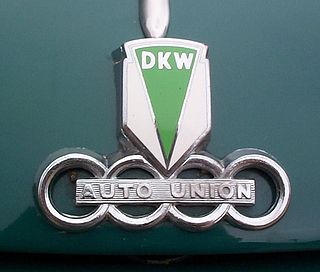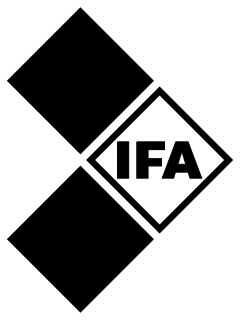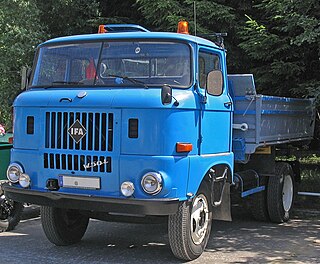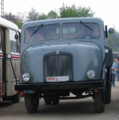
DKW is a German car and motorcycle marque. DKW was one of the four companies that formed Auto Union in 1932 and is hence an ancestor of the modern day Audi company.
Trabant is a series of small cars produced from 1957 to 1991 by former East German car manufacturer VEB Sachsenring Automobilwerke Zwickau. In total, four different models were made, the Trabant 500, Trabant 600, Trabant 601, and the Trabant 1.1. The first Trabant model, the Trabant 500, was a modern car when it was introduced in 1957. It featured a duroplast body mounted on a one-piece steel chassis, front-wheel drive, a transverse two-stroke engine, and independent suspension. However, this 1950s design remained largely unchanged until the introduction of the last Trabant model, the Trabant 1.1 in 1990. Hence, the Trabant became a symbolic of the stagnant economy of former East Germany and the collapse of the Eastern Bloc in general. Called "a spark plug with a roof," 3,096,999 Trabants were produced. Older models have been sought by collectors in the United States due to their low cost and fewer restrictions on the importation of antique cars. The Trabant also gained a following among car tuning and rally racing enthusiasts.

Motorenwerke Zschopau GmbH is a German motorcycle manufacturer located in Zschopau, Saxony. The acronym MZ since 1956 stands for Motorenwerke Zschopau GmbH. From 1992 to 1999 the company was called MuZ, an acronym for Motorrad und Zweiradwerk.

Auto Union AG, Chemnitz, was an amalgamation of four German automobile manufacturers, founded in 1932 and established in 1936 in Chemnitz, Saxony. It is the immediate predecessor of Audi as it is known today.

Barkas was the East German manufacturer of small delivery vans and minibuses named the B 1000. In addition to delivery vans, Barkas also made engines for Trabant cars.

Horch[hɔʁç] was a car brand manufacturer, founded in Germany by August Horch & Cie at the beginning of the 20th century.

HQM Sachsenring GmbH is a Zwickau-based company that supplies chassis and body parts to the automotive industry. The company was named after the Sachsenring race track. Founded as VEB Sachsenring after the end of World War II, Sachsenring was one of the few manufacturers of vehicles in East Germany, its best known product being the Trabant, produced betwwen 1957 and 1991. Following the reunification of Germany in 1990, Sachsenring transitioned from a government-owned company under a centrally-planned economy to a private corporation in a free market economy.
The Automobilwerk Eisenach (AWE) was an automobile manufacturer in Eisenach, Germany.

Robur was a marque of the Volkseigener Betrieb VEB Robur-Werke Zittau of East Germany (GDR). It mainly produced 3-ton trucks. The vehicles were produced in the town of Zittau in what now is South-East Saxony. Until 1946, company produced under the marque Phänomen, and until 1957 under the name VEB Phänomen Zittau.

The AWZ P70 "Zwickau" is a small family car which was produced in East Germany by VEB Automobilwerke Zwickau (AWZ) between 1955 and 1959.

The Horch P240 or Sachsenring P240 was a luxury car built by the VEB Kraftfahrzeugwerk Horch Zwickau in East Germany between 1955 and 1959. The P240 was the first executive car developed by the company, after the Second World War and its re-location into the Eastern Bloc, after the Soviet Union had acquired the Eastern part of Germany.

The Wartburg 353, known in some export markets as the Wartburg Knight, is a medium-sized family car, produced by the East German car manufacturer AWE for their Wartburg brand. It was the successor of the Wartburg 311, and was itself succeeded by the Wartburg 1.3.

The IFA F9, subsequently rebadged as the EMW 309, was a compact saloon manufactured under the auspices of the Russian and East German states between 1949 or 1950 and 1956. It was initially built at Zwickau at the plant previously owned by Auto Union. In 1953 production was transferred to the EMW, former BMW manufacturing plant at Eisenach under the name EMW 309 until 1956 where its underpinnings subsequently found their way into the Wartburg 311.

The DKW F8 compact front-wheel drive two-stroke engined saloon was introduced in 1939. The F8 was slightly shorter than its predecessor despite having a marginally increased wheelbase. The base model, known as the Reichsklasse, was manufactured only till 1940 but the Meisterklasse sedan continued in production until 1942. In addition to the saloons, cabriolet versions were offered.

The Wartburg 311 was a car produced by East German car manufacturer VEB Automobilwerk Eisenach from 1956 to 1965. The 311 model was manufactured in a number of variations, including pickup, sedan, limousine, coupé, and as a two-seat roadster. The two-stroke engine was enlarged to 992 cc in 1962. An interim model, called the Wartburg 312 and featuring the chassis developed for the succeeding 353, was built from 1965 until 1967.

Industriewerke Ludwigsfelde is an automotive factory in Ludwigsfelde in Brandenburg, just south of Berlin in Germany. The factory is part of Daimler AG and since 1991 it has made Mercedes-Benz vans. It is also the producer of the Multicar line of automobiles.

The August Horch Museum Zwickau is an automobile museum in Zwickau, Saxony, Germany. Opened in 2004, it covers the history of automobile construction in Zwickau, the home of Horch and Audi prior to World War II, and Trabant during the Cold War-era German Democratic Republic.

The Wartburg 1.3 is a car which was produced by Automobilwerk Eisenach between October 1988 and April 1991. The car was an updated version of the Wartburg 353, with a 1.3-litre, four-stroke, four-cylinder engine as also used in the second generation Volkswagen Polo, instead of the original 1-litre, two-stroke, three-cylinder unit found in the 353.

The IFA W 50 is a medium-duty truck built by the East German IFA conglomerate at their Ludwigsfelde plant from 1965 until 1990. A total of about 572,000 were built in Ludwigsfelde, with an unknown additional number of special-use vehicles assembled at other plants. It was meant to be succeeded by the IFA L 60 but outlived it by several months. IFA ended all truck production on 17 December 1990, following the reunification of Germany.

Peter Kurze is a German publisher and author. He became known through his book series on the history of the automobile.
















































